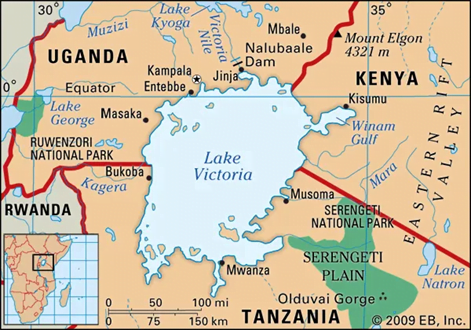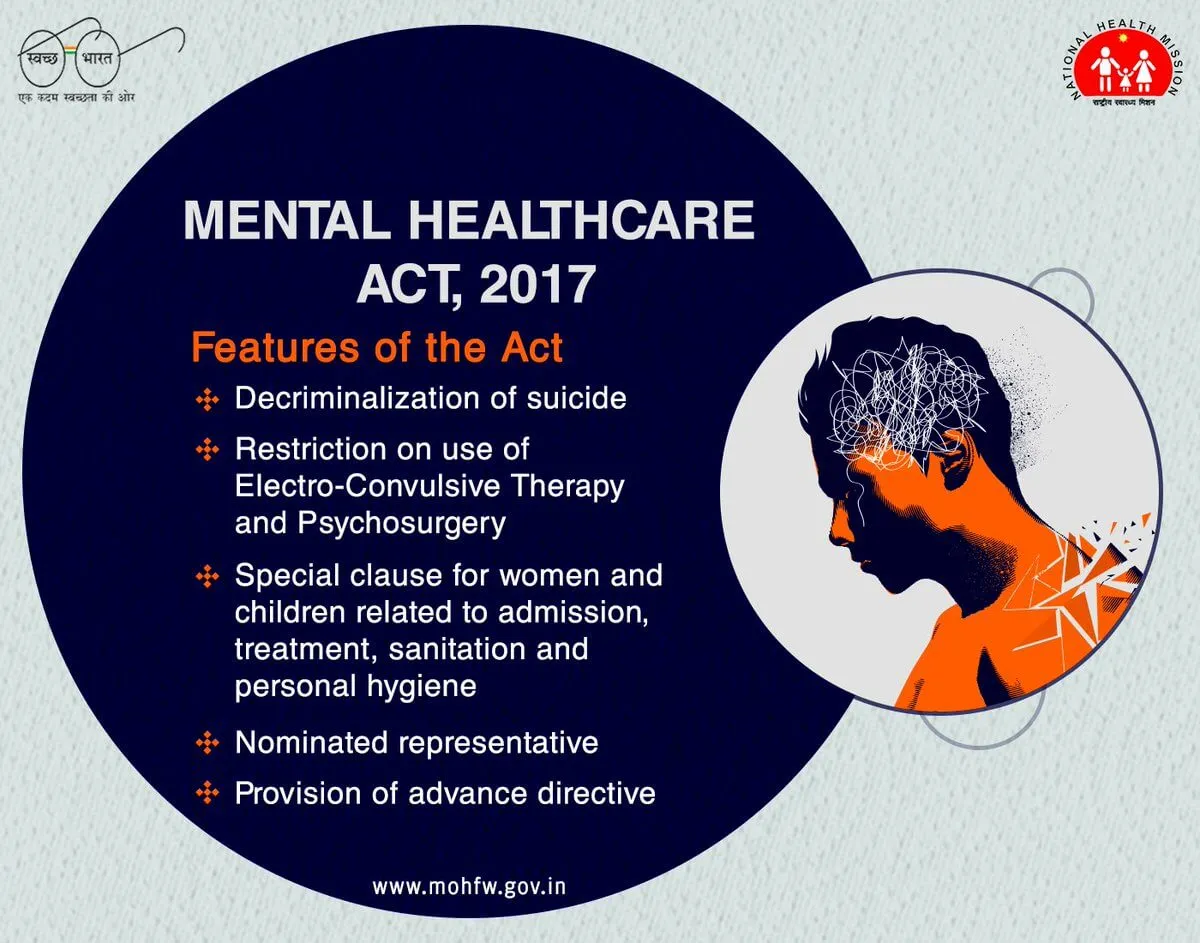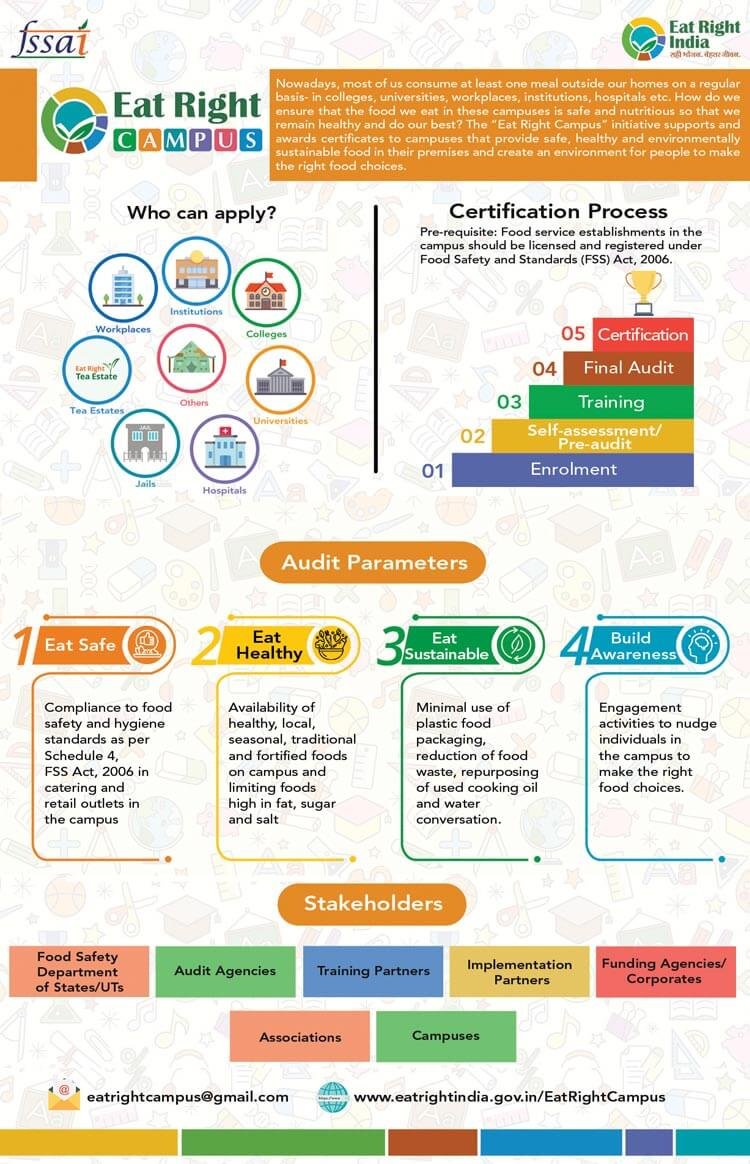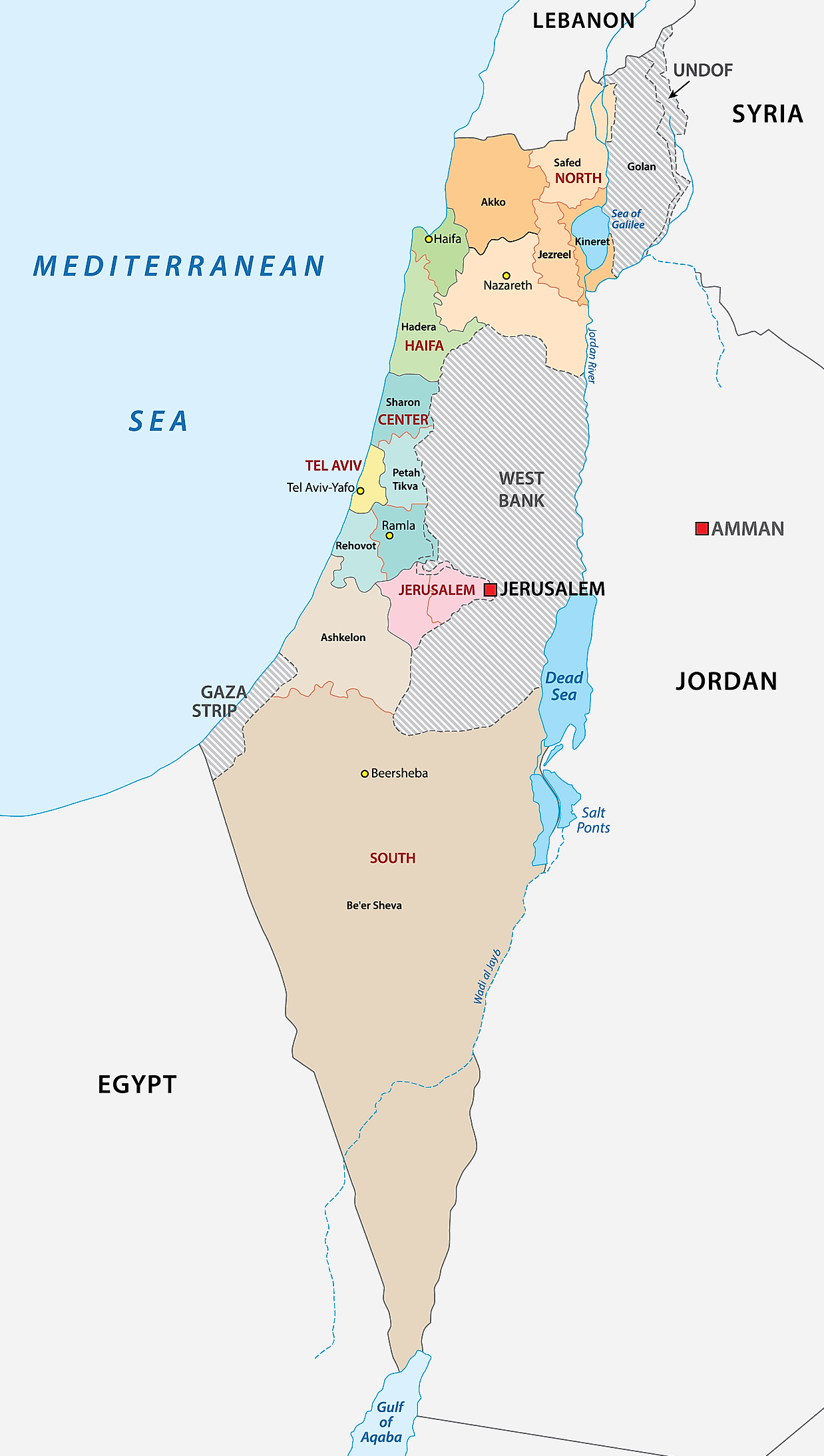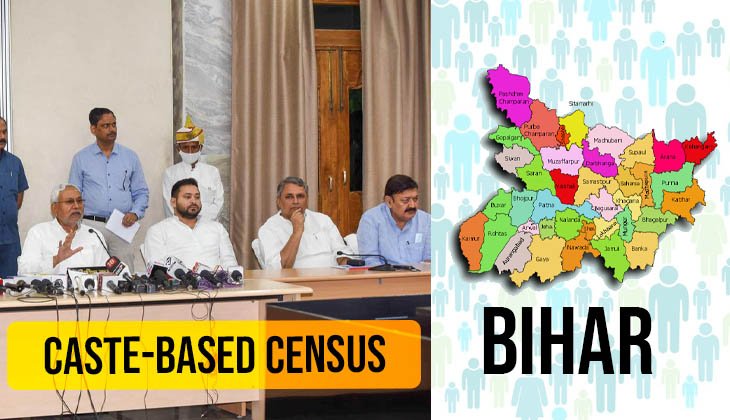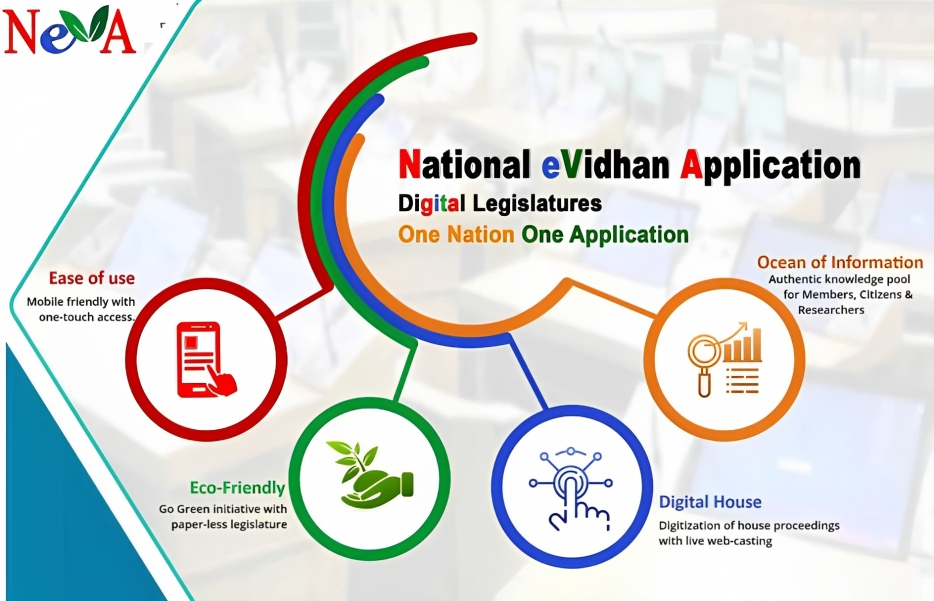
Current Affairs December 23, 2023: Export Ban of Rare Earth Technologies, National Mineral Policy 2019, Project PRAYAS, National SC/ST Hub, Bir Tawil, National Mathematics Day
Subscribers of "Current Affairs" course can Download Daily Current Affairs in PDF/DOC
Subscribe to Never Miss an Important Update! Assured Discounts on New Products!
Must Join PMF IAS Telegram Channel & PMF IAS History Telegram Channel
{GS2 – IR – China} Export Ban of Rare Earth Technologies
- Context (TH): China, the world’s top processor of rare earths, banned the export of technology to extract and separate the rare earth metals.
Rare Earth Elements (REEs)
- REE are a group of 17 chemical elements.
- They comprise the 15 lanthanide elements, along with scandium and yttrium.
- They are relatively abundant in Earth’s crust.
- They are rare because they are found in low concentrations and mixed with other minerals, making them difficult and expensive to extract.
- REEs are used to make magnets for electric vehicles (EVs), wind turbines, weapons, etc.
- They are used in electric vehicle (EV) motors, medical devices, weaponry, etc.
- REEs are divided into Heavy (HREEs) and Light (LREEs).
- LREEs are abundant, while HREEs are more critical due to their high demand and low availability.
- Among LREEs, neodymium is the most critical as it is extensively used in all mobile phones, medical equipment and electric vehicles.
- HREEs (like dysprosium, yttrium, and cerium) are critical for clean energy technologies; however, due to their limited supply, they have a small market.

China’s Position in REE Related Markets
- China has a monopoly in the REEs-related market.
- It accounted for more than 2/3rd of mined REEs last year.
- It constitutes nearly 90% of global refined REE output.
- It also dominates the supply of rare-earth magnets.

Reason Behind the China’s Ban
- China has banned the export of rare earth technologies on the grounds of national security.
- But the real motive is to make it harder for the US and its allies to bolster Western supplies of REE.
- The latest move comes as the US and EU become more concerned about China’s growing exports of clean energy products and its dominance of key supply chain portions.
Consequences of China’s Move
- Lower adoption of green energy products: The Conference of Parties 28 to UNFCCC held in UAE has outlined an urgent shift to green energy products due to the growing climate crisis.
- Trade tensions and disputes: In retaliation to China’s ban, the USA and the EU will increase tariffs on EVs from China.
- Increased costs and supply chain disruptions: Western countries and other nations may face higher production costs and delays in manufacturing products using REEs.
- Geopolitical risks and dependencies: China’s monopoly over REE processing technology can create vulnerabilities for other countries in future.
- Shifting power dynamics: China’s dominance in REE processing technology enhances its global trade leverage and potentially amplifies its influence in critical technology sectors.
{GS2 – IR – Diaspora} Project PRAYAS
- Context (MEA): The International Organisation for Migration (IOM) launched Project PRAYAS (Promoting Regular & Assisted Migration for Youth and Skilled Professionals) in partnership with Ministry of External Affairs.
- It is a joint collaboration between the IOM India and Indian Council of World Affairs (ICWA).
- It envisages development of a roadmap for improved coordination between Central and State Governments to encourage sharing of best practices between States and enhanced engagement with the MEA on matters related to the international migration cycle.
- The project adheres to the objectives of the Global Compact for Safe, Orderly and Regular Migration (GCM) and the Migration Governance Framework (MiGOF).
- It also aligns with Goal 10.7 of the 2030 Agenda for Sustainable Development Goals (SDGs) to facilitate orderly, safe, regular, and responsible migration and mobility of people.
Indian Diaspora
- It encompasses people who can trace their origins to India or are Indian citizens living abroad, temporarily or permanently.
- The Diaspora constitutes Non-Resident Indians (NRIs), Persons of Indian Origin (PIOs) or Overseas Citizens of India (OCI) which reflects the rich social, ethnic, religious, and cultural tapestry of India.
- India has a 32 million-strong diaspora with UAE, USA, Saudi Arabia hosting the largest Diaspora.
- Indian Diaspora contributes largest remittance flow in world – Nearly $80 Billion (3% of Indian GDP).
Role of Diaspora in making India Self Reliant
- Promoted the concept of ‘Indianness’: From Bollywood celebrities endorsing Indian fashion on global red carpets to Indian chefs popularizing Indian cuisines in international culinary scenes, Indian diaspora has seamlessly integrated into societies worldwide.
- Leveraging Diaspora Investment: Real-world instances of diaspora investments can be seen in successful startups, innovative entrepreneurial ventures, and advancements in technology.
- Promotes GoI idea of ‘Vocal for Local’: E.g., the preference for Indian tea brands, embrace of Indian textiles by fashion influencers abroad contribute to building trust in Indian products globally.
- Source of remittances accounting for 13% of global remittances & 3% of country’s GDP.
- Leveraging Diaspora Diplomacy: From Sundar Pichai, Har Gobind Khoran to Political figures like Kamala Harris acting as a tool of Soft power in the era of Hard power by influencing policy matters.
- Role in Research & Innovation: The Indian diaspora can act as ‘living bridges’ to make India self-reliant in next generation technologies. E.g. Vaibhav Summit.
Challenges faced by Indian Diaspora
- Heterogeneous Nature with Differential needs demanding differential support from Government. E.g. Welfare measures by Gulf Diaspora, Investment opportunities by Diaspora in wealthier nations.
- Regulatory Cholesterol & Bureaucratic Hurdles like red tape, multiple clearances, corruption, etc. discourages diaspora to collaborate with India or to invest in the country.
- Protectionism measures by host countries: Due to the global slowdown, unemployment worldwide, the restriction on immigration has impacted Indians. E.g. “Nitaqat” policy of Saudi Arabia.
- Disturbances in the Middle West: Shia-Sunni conflict, sudden eruption of violence as seen during Hamas Israel conflict presenting challenge of sudden evacuation from turbulent regions.
- Other threats: Racism and religious discrimination, social isolation, exploitation from local employers (for e.g. Kafala System in Gulf countries) etc.
Way Forward
- Organizing Programmes on lines of Pravasi Bharatiya Divas to engage with them, update them on the policies and celebrate their achievements.
- Grievance redressal mechanism for effective resolution of grievances of the Diaspora.
- Effective investment options for diaspora via Infrastructure Bonds tailored to attract NRI/PIO investments, drawing inspiration from the Israel Bonds model.
- Promoting ease of doing business to tap diaspora’s contribution to Self-Reliant India.
- Effective outreach to communicate GoI policies and programmes to build greater confidence among the diasporas.
- Other measures: Addressing problems of blue-collar workers working overseas, focus on promoting tourism among 2nd generation PIOs, etc.
GoI Initiatives for Indian Diaspora
- Indian Community Welfare Fund (ICWF) to support Indian nationals in crisis situations abroad.
- Madad Portal for online lodging of grievance for emigrants & Social security through Pravasi Suraksha Yojna.
- SWADES (Skilled Workers Arrival Database for Employment Support) to conduct skill mapping of the returning citizens under the Vande Bharat Mission.
- Vande Bharat Mission for repatriation of Indian diaspora during COVID, and Operation Raahat and Sankat Mochan for evacuation of people stuck in conflict zones etc.
- Global Pravasi Rishta Portal, Vaibhav (Vaishwik Bharatiya Vaigyanik) Summit, Know India Programme, Tracing Roots, Pravasi Teerth Darshan Yojana etc for better engagement with Diaspora.
{GS2 – IR – India-France} Republic Day Chief Guest
- Context (IE): France’s President Macron will be chief guest for the 2024 Republic Day celebrations.

Process to choose Republic Day Chief Guest
- Nature of the relationship with the concerned country, political, commercial, military and economic interests of India, and association with the Non-Aligned Movement (NAM) are some criteria.
- Name of the Chief Guest is finalised by the approval of the PM and the President.
- The concerned consulate then discreetly ascertains the availability of the potential chief guest.
- After a candidate is finalised, official communication takes place.
- The first Chief Guest of the parade in 1950 was President Sukarno of Indonesia, one of the five founding members of the NAM.
Non-Alignment Movement
|
{GS2 – MoM – Initiative} National Mineral Policy 2019 for Sustainable Mining
- Context (PIB): National Mineral Policy 2019 (NMP 2019), which replaced the National Mineral Policy 2008, emphasises sustainable mining.
National Mineral Policy 2019 (NMP 2019)
- NMP 2019 states minerals are valuable natural resources, and national goals and perspectives must guide their utilisation.
Focus of NMP 2019
- Promote domestic industry.
- Reduce import dependency and contribute to the Make in India initiative.
- A fair and transparent allocation of mineral resources to ensure equitable distribution.
- Ensure environmentally sustainable mining, with stakeholders’ participation.
- Devolution of benefits of mining to mining-affected persons and areas.
- Maintaining a high level of trust among all stakeholders.
- Conducive regulatory environment for ease of doing business in the sector.
- Gender sensitivity.
Key Provisions of NMP 2019
- Introduction of Right of First Refusal for RL/PL holders
- Encouraging the private sector to take up exploration.
- Auctioning in virgin areas for composite RP cum PL cum ML on a revenue share basis
- Encouragement of merger and acquisition of mining entities
- Transfer of mining leases to encourage private-sector mining areas.
- Creation of dedicated mineral corridors to boost private-sector mining areas.
- Proposes to grant the status of industry to mining activity to enhance private-sector financing.
- Mentions a long-term import-export policy for minerals.
- Efforts to harmonise taxes, levies, and royalties with global benchmarks.
- Rationalise unused reserved areas allocated to PSUs and auction them.
- Incorporation of E-Governance, IT-enabled systems, awareness and information campaigns.
|
Other Initiatives for Sustainable Mining
Mines and Minerals (Development and Regulation) Act, 1957 (MMDRA 1957)
- It empowers the GoI to set rules for mineral conservation, systematic development, and environmental protection in mining operations.
- Accordingly, Mineral Conservation and Development Rules (MCDR), 2017 which provides for:
- Precaution against air pollution: License or leaseholders must minimise air pollution from fines, dust, smoke, or emissions within permissible limits during mining operations.
- Permissible limits and standards: Adhere to standard and permissible limits for pollutants, toxins, and noise as notified by relevant authorities under current laws.
Environmental Clearance from the MoEF
- The project proponent must monitor plant premises for fugitive emissions quarterly using labs recognised under the Environment (Protection) Act, 1986.
- Appropriate Air Pollution Control (APC) systems shall be provided for all the dust-generating points.
State Pollution Control Board (SPCB) and CPCB
- SPCB and CPCB monitor pollution levels in mines as per their guidelines.
- Ambient air monitoring is carried out in the core zone and buffer zone through a laboratory recognised by MoEF&CC under the Environment (Protection) Act, 1986.
- National Ambient Air Quality Standard, 2009, is adhered to for monitoring fugitive dust emission.
{GS2 – MoMSME – Schemes} National SC/ST Hub
- Context (PIB): The MoMSME recently gave information on the Scheme in the Lok Sabha.
- It is a central sector scheme of Ministry of Micro Small and Medium Enterprises (MoMSME).
- Applicability: Existing and Aspiring SC/ST Entrepreneurs.
- The scheme aims at providing professional support to SCs and STs entrepreneurs to fulfil the obligations under the Central Government Public Procurement Policy for Micro and Small Enterprises Order 2012, adopt applicable business practices and leverage the Stand-Up India initiative.
- Key action areas: Vendor development, participation in public procurement, building reliable database, mentoring and handholding support, policy advocacy with states, credit facilitation, capacity building, private affirmative action, technology upgradation, marketing support, and special subsidies under various schemes.
Benefits
- Achieve 4% Public Procurement target from SC-ST entrepreneurs.
- Facilitating SC/ST entrepreneurs to be part of vendor development programs and mentoring support.
- Collection, collation and dissemination of information regarding SC/ST enterprises and entrepreneurs.
- Distribution of trade specific tool kits to trained candidates.
{GS2 – Polity – IC – Citizenship} Passports: Evolution and Features
- Context(IE): The recent film ‘Dunki’ focuses on the issue of immigration and the history of passports.
Evolution of Passports
|
Indian Passport
- For the first time, under the Defence of India Act 1915, possessing a passport for leaving and entering India was compulsory. Later, the Indian Passport Act of 1920 was passed.
- In 1952, old passports were revoked. New Indian passports were granted only to “respectable” people.
- The Supreme Court in the Satwant Singh Sawhney vs D. Ramarathnam case (1967) ruled that every citizen had the right to a passport. Subsequently, the Indian Passport Act 1967 was passed.
- A passport is proof of address as well as citizenship.
Types of Indian Passport
- Ordinary Passport (P-type): A dark blue cover passport is issued to ordinary citizens for private travel, such as vacation, study and business trips.
- Official Passport (S-type): A white cover passport is issued to individuals representing the Government of India on official business, including members of the Indian Armed Forces stationed abroad.
- Diplomatic Passport (D-type): A maroon cover passport is issued to Indian diplomats, Members of Parliament (MPs), members of the Union Council of Ministers, certain high-ranking government officials and diplomatic couriers, and their dependents.
- Diplomatic and official passports are now issued as ePassports (Biometric).
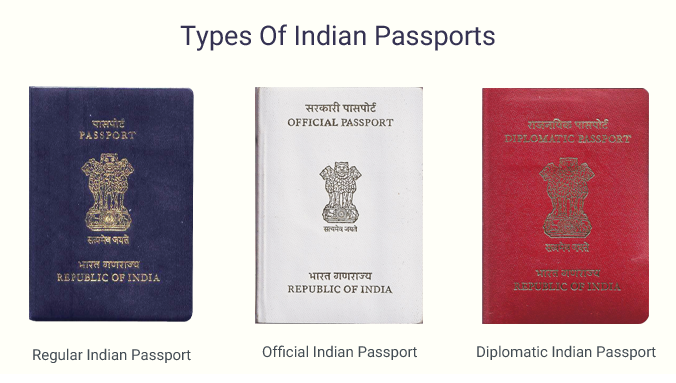
Other features of the Indian Passport
- All passports contain a note from the President of India to allow safe passage to Indian citizens.
- The language allowed on the passport is Hindi and English only.
- India secures 80th rank on the Henley Passport Index 2023.
{GS2 – Polity – IC – FRs} Press and Registration of Periodicals (PRP) Bill 2023
- Context (PIB): Lok Sabha passed the Press and Registration of Periodicals (PRP) Bill, 2023.
- The Bill replaces the Press and Registration of Books (PRB) Act 1867.
Press and Registration of Books Act, 1867
|
Provisions of the PRP Bill 2023
- The Bill simplifies the registration process for periodicals.
- One-time registration is mandated for digital news platforms.
- The Bill empowers the Press Registrar General (PRG) to suspend/cancel registration.
- Convicts of terrorist acts, unlawful activity, or acts against the state’s security will not be allowed to operate periodicals.
- Foreign periodicals can be printed in India with prior approval of the Central Government.
- The requirement to file a declaration before the District Magistrate is replaced with Online intimation.
- Decriminalisation: A six-month prison term is specified only for the continued operation of non-registered periodicals after direction by PRG.
- Any refusal of grant of registration and penalty or cancellation can be appealed against.
- The Press and Registration Appellate Board will comprise the Chairperson-Press Council of India (PCI) and two members of the PCI.
|
Significance of the PRP Bill 2023
- Transparency and ease of doing business by simplification of process.
- Bill covers digital media, addressing the issue of fake news.
- Books are excluded from the PRP Bill’s purview, administered by the Ministry of Education.
Criticism of PRP Bill 2023
- Expansion of power beyond PRG, including law enforcement agencies, can restrict press freedom.
- The power to enter the premises of Press organisations to PRG is considered intrusive.
- Concerns are being raised against the power to frame rules for the Central government.
{GS3 – Agri – Storage} World’s Largest Grain Storage Plan in Cooperatives
- Context (FE): The World’s Largest Grain Storage Plan in the Cooperative Sector has been running in 24 states/UTs of India.
- The marquee project aims to create Agri infrastructures at the Primary Agricultural Credit Societies level.
- PACS infrastructure will include Warehouses, Custom Hiring Centers, and Fair Price Shops.
- It will be implemented at the block level through PACS.
- It will be under the administrative control of the Ministry of Cooperation.
- It will be implemented by the National Cooperative Development Corporation (NCDC) in collaboration with NABARD, Central Warehousing Corporation (CWC), and Food Corporation of India (FCI).
Benefits of the Project
- It will enhance the economic viability of PACS.
- Farmers could avoid distress sales due to storage availability and the facility to avail finance through the PACS.
- Diversification of business will generate additional sources of income for farmers.
- Food security can be ensured through the National Food Security Act 2013, backed by a robust storage network.
{GS3 – Envi – Species} Java Stingaree (Urolophus javanicus)
- Context (TWC): Java stingaree became the first marine fish to become extinct.
- This species is characterised by an oval-shaped pectoral fin disc longer than wide, a tail with a dorsal fin in front of the stinging spine and a caudal fin.
- Declared extinct because it has not been recorded since its discovery over 150 years ago.
- Reason for extinction: Heavy fishing pressure and habitat degradation.
- Distribution: Only found off Java.
- Habitat: Inhabit waters of the continental and insular shelves.
- Conservation status: IUCN: Extinct

{GS3 – Envi – UNFCCC} Nationally Determined Contribution (NDC)
- Context (PIB): India has achieved two older NDC targets well ahead of time.
- These two targets are related to emissions intensity and non-fossil fuel-based energy.
What are Nationally Determined Contributions (NDCs)?
- NDC is a non-binding climate action plan to cut emissions and adapt to climate impacts.
- Each party to the Paris Agreement must establish an NDC and update it every five years.
- They are the UNFCCC‘s first greenhouse gas targets, applying equally to developed and developing nations.
Paris Agreement
- The Paris Agreement is a legally binding international treaty on climate change.
- It was adopted at the Conference of the Parties 21 (COP 21) to UNFCCC in Paris in 2015.
- It aims to limit global warming to well below 2°C and preferably limit it to 1.5°C, compared to the pre-industrial level.
- India is a party to UNFCCC and a signatory to the Paris Agreement.
India’s NDC at COP 21 (Paris)
- India’s original NDC contained three main targets for 2030:
- A 33 to 35% reduction in emissions intensity (or emissions per unit of GDP) from 2005 levels.
- At least 40% of total electricity generation to come from non-fossil renewable sources.
- An increase in forest cover to create an additional carbon sink of 2.5 to 3 billion tonnes of carbon dioxide equivalent.
India’s Updated NDC at COP 26 (Glasgow)
- At COP 26, India made five promises called ‘Panchamrit’ to strengthen India’s climate commitments.
- Two were upward revisions of existing NDC targets, i.e., emissions intensity and non-fossil fuel-based energy targets.
- India revised its NDC targets as it was on its way to meeting existing goals before the 2030 deadline.
- Now, in 2023, both old NDC targets have been surpassed.
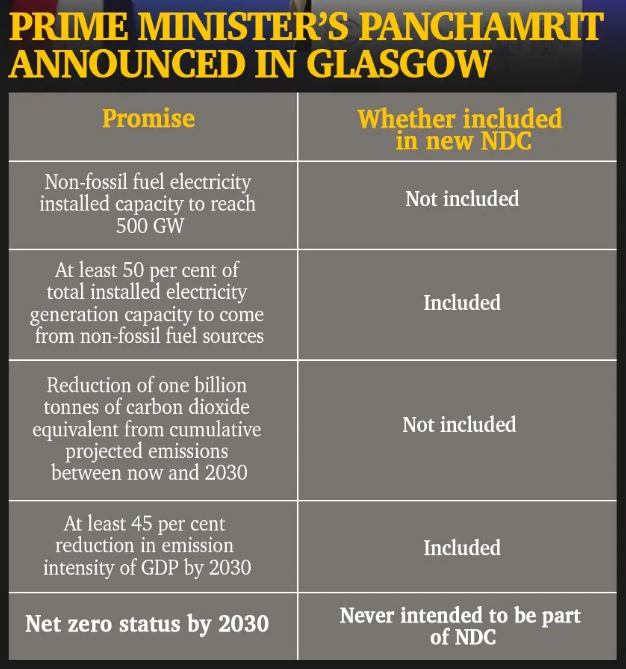
Present Status of the Updated NDC Targets
- 43.81% of total electricity generation comes from non-fossil fuel-based energy resources.
- Emission intensity has been reduced by 33% between 2005 and 2019.
Challenges in Achieving the Updated NDC Targets
- High dependence on fossil fuel-based electricity: Over 57% of electricity is still fossil fuel-based.
- Rise in CO2 emissions: India’s 2030 carbon emissions may range from 35 to 40 billion tonnes. A one-billion-tonne reduction will signify a 2.5 to 3% decrease.
- Infrastructure cost: Incorporating renewable energy into the grid demands substantial investments in storage, grid modernisation, and smart grid technologies.
- Limited domestic resources
Way Forward
- International collaboration: E.g., India and France launched the International Solar Alliance (ISA), which provides a platform for cooperation among solar-rich countries to work for efficient consumption of solar energy to reduce dependence on fossil fuels.
- Providing incentives: E.g., under the National Green Hydrogen Mission, incentives are provided for green hydrogen production.
- Adopting updated technology: E.g., in the nuclear power sector, moving beyond Pressurized Heavy Water Reactors (PHWRs), India is exploring Light Water Reactors (LWRs) and Small Modular Reactors (SMRs). These offer faster deployment, potentially lower costs, and enhanced safety features.
- Using ICT to raise awareness: E.g., e-AMRIT is a one-stop portal for creating awareness about Electric Vehicles (EVs) in India, providing all information about policies, incentives, charging stations, etc.
- Addressing infrastructure issues: E.g., the Green Energy Corridor Scheme was launched to synchronise electricity produced from renewable sources with conventional power stations in the grid.
- Fixing loopholes in policies and acts: E.g., Forest (Conservation) Amendment Act, 2023 permits private forest diversion without clearance, aiming to incentivise afforestation. But this provision eases using afforested land as ‘carbon credits‘.
- Policy support to allied sectors: E.g., Ethanol is a biofuel produced by yeast fermentation of sugars or starches. So, there should be agriculture policies supporting ethanol-producing crops.
{GS3 – IE – Industry} National Startup Advisory Council
- Context (PIB): Upon completion of two year term of the ‘National Startup Advisory Council’ (NSAC), the Central Government has nominated the non-official members to the council.
- The Council was constituted by the Department for Promotion of Industry and Internal Trade (DPIIT) under the Ministry of Commerce and Industry.
- Chairman: Minister for Commerce & Industry.
- Ex-officio Members: Nominees of the concerned Ministries/Departments/Organisations not below the rank of Joint Secretary.
- The council also has non-official members, representing various stakeholders such as founders of successful startups, veterans who have grown and scaled companies in India.
- The non-official members are appointed for a period of two years.
- Convener of the Council: Joint Secretary, Department for Promotion of Industry and Internal Trade.
- Objective: To advise the Government on measures needed to build a strong ecosystem for nurturing innovation and startups in the country to drive sustainable economic growth and generate large scale employment opportunities.
For detailed explanation on Startups >PMF IAS November 2023 Monthly Magazine.
{Prelims – In News} Green Nobel Prize
- Context (TH): The great-grandnephew of Alfred Nobel is offering a “Green Nobel” prize, unrelated to the Nobel Foundation, to environmental champions of the Amazon rainforest.
- The United Earth Amazonia prize will be awarded in the 130-year-old Opera House in Manaus.
{Prelims – PIN World – Africa} Bir Tawil
- Context (PIB): Bir Tawil is the only place on earth that belongs to no country.
- It is ruled by no state, inhabited by no permanent residents and governed by no laws.
- It is wedged between the borders of Egypt and Sudan and yet claimed by neither.
- Its unusual status is a byproduct of British colonial machinations in northeast Africa.
- After decades-long fighting between Egyptian and British forces on the one side and Mahdist rebels in Sudan on the other, the border is decided as the 22nd parallel, cutting through the Nubian desert.
- But three years later, however, the British drew up another document. This document assigned:
- Bartazuga Mountain (south of the 22nd parallel), inhabited by the Ababda tribe, with stronger ties to Egypt than Sudan, to Egypt.
- Hala’ib, a triangular area bordering the Red Sea (north of the 22nd parallel), inhabited by the Beja people, with stronger ties to Sudan than Egypt, to Sudan.
- After independence in 1956, Sudan claimed the mineral-rich Hala’ib triangle.
- But Eygpt denied the claim, saying that reassignment was temporary.
- As a result, both countries avoid asserting sovereignty over Bir Tawil (near Bartazuga mountain) to avoid renouncing their claims to the more valuable Hala’ib triangle.
- So. in practice, Bir Tawil has the legal status of terra nullius (nobody’s land).

{Prelims – PIN} National Mathematics Day
- Context (IE): National Mathematics Day has been celebrated annually on 22nd December to mark the birth anniversary of Srinivasa Ramanujan since 2012.
Srinivasa Ramanujan
- He was born on 22nd December 1887 in Erode, Tamil Nadu.
- In 1903, he secured a scholarship to the University of Madras but lost it due to failing in other subjects.
- In 1911, Ramanujan published the first of his papers in the Journal of the Indian Mathematical Society.
- His correspondence with British Mathematician G.H. Hardy led to a special scholarship from the University of Madras and a grant from Trinity College, Cambridge.
- He was elected to the Royal Society of London in 1918.
- Ramanujan was the first Indian elected a Trinity College, Cambridge University Fellow.
Legacy of Ramanujan
- Ramanujan compiled results of various equations & identities. The infinite series for Pi is one of them.
- He developed new ways to solve many challenging mathematical problems, leading to the evolution of game theory.
- 1729 is known as the Ramanujan number, the smallest number that can be expressed as the sum of two different cubes in two different ways.
- “The Man Who Knew Infinity” is a biography and a movie on the life of Ramanujan.
Awards in Mathematics
|





![PMF IAS Environment for UPSC 2022-23 [paperback] PMF IAS [Nov 30, 2021]…](https://pmfias.b-cdn.net/wp-content/uploads/2024/04/pmfiasenvironmentforupsc2022-23paperbackpmfiasnov302021.jpg)
